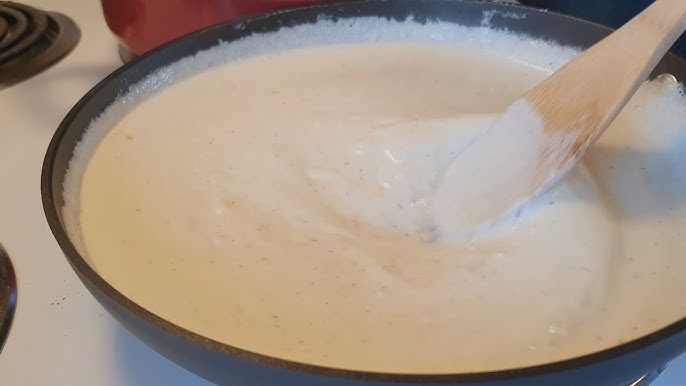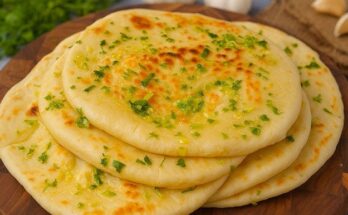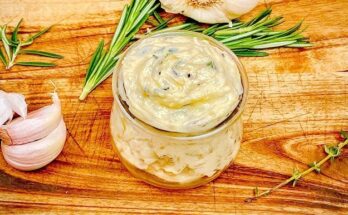Garlic Parmesan Sauce Recipe: If you’ve ever dipped into a basket of garlic parmesan wings or devoured a plate of creamy pasta coated in white sauce, you know the magic of garlic parmesan sauce. It’s creamy, rich, garlicky, and packed with that salty, nutty flavor that only real parmesan cheese can deliver. Whether you’re using it as a pasta sauce, a dip for wings, or a drizzle for veggies, this sauce is a true flavor bomb.
The best part? You don’t need to be a pro chef to make it. With the right ingredients and a little kitchen time, you can whip up a batch of garlic parmesan sauce that’ll rival your favorite restaurant’s version—if not beat it. Let’s break down everything you need to make this creamy goodness at home.
Why You’ll Love This Recipe
Let’s be real: there are a lot of sauces out there. So why should you go for garlic parmesan? For starters, it’s ultra-versatile. It goes with chicken, pasta, vegetables, fries, pizza—honestly, just about anything you can dream up. It’s the kind of sauce that makes people ask, “What is in this?!”
Here’s why this recipe stands out:
- Incredibly creamy with just the right thickness.
- Bursting with flavor from fresh garlic and real parmesan.
- Takes less than 20 minutes from start to finish.
- Easily customizable—spice it up, add herbs, make it low-fat.
- Great for make-ahead meals and weekly meal prep.
Plus, if you’re someone who wants to skip processed sauces filled with unpronounceable ingredients, this homemade version is a clean, wholesome upgrade. And yes, it tastes better than store-bought.
List of Ingredients You’ll Need
Creating the perfect garlic parmesan sauce is all about balance. You want creamy, cheesy, and garlicky in just the right proportions. Here’s what you’ll need to get started:
Fresh Ingredients
- Garlic (3–4 cloves, minced): The real star of the show. Fresh garlic packs the punch you need for bold flavor.
- Parmesan cheese (¾ cup, finely grated): Choose a high-quality block and grate it yourself if possible.
- Butter (4 tablespoons): Adds richness and forms the base of the roux.
- Heavy cream (1 cup): Gives the sauce its luscious, creamy texture.
Pantry Ingredients
- Olive oil (1 tablespoon): Helps sauté the garlic without burning it.
- Salt (to taste): Enhances the flavor of everything.
- Black pepper (¼ teaspoon): Adds a touch of warmth.
- Flour (1 tablespoon, optional): Helps thicken the sauce if needed.
Optional Add-Ons
- Red chili flakes: For a little heat.
- Fresh parsley or basil: For garnish and a herby lift.
- Nutmeg (a pinch): Adds subtle warmth and depth.
You probably have most of these in your kitchen already, which makes this recipe an easy go-to for weeknight dinners or last-minute gatherings.
Choosing the Right Parmesan Cheese
You might be tempted to reach for the pre-shredded parmesan, but hold up—quality matters here. The flavor of your garlic parmesan sauce hinges on using real, high-quality parmesan cheese.
Skip the green bottle stuff. You know the one. That’s processed and doesn’t melt well. Instead, go for:
- Parmigiano-Reggiano: Authentic, nutty, aged Italian cheese that melts beautifully.
- Grana Padano: A milder but still delicious option.
- Domestic parmesan: Works in a pinch, but make sure it’s fresh and not overly dry.
Pro tip: Always grate your cheese fresh. It melts more smoothly and delivers a richer flavor than the pre-shredded kind, which often contains anti-caking agents that mess with the sauce’s texture.
Fresh Garlic vs. Garlic Powder – What Works Best?
Here’s the truth: nothing beats fresh garlic when it comes to depth of flavor. When you sauté fresh minced garlic in butter and oil, you get this incredible aroma and taste that garlic powder just can’t replicate.
But in case you’re in a bind:
- Fresh garlic = robust, sweet-spicy flavor.
- Garlic powder = mild, background flavor.
If you’re using garlic powder, go light—start with ½ teaspoon and adjust. However, if you want the sauce to really sing, stick with the fresh cloves. Trust us, it’s worth the extra two minutes of prep.
Cream or Milk? The Right Base for Creaminess
This decision depends on how rich you want your sauce. Cream makes it thick and luxurious, while milk makes it lighter but still creamy.
- Heavy cream: Best for full-flavored, thick sauce.
- Half-and-half: A lighter choice that still gives you creaminess.
- Whole milk: Makes a thinner sauce, but still works if that’s what you have.
Avoid skim milk or low-fat alternatives unless you plan to thicken the sauce with a roux. They lack the fat content needed for that velvety texture.
Butter: The Foundation of Flavor
Butter isn’t just a fat here—it’s the foundation of the sauce’s flavor. It’s what the garlic gets sautéed in. It’s what blends with the flour (if you’re using it) to form a roux. And it’s what gives the sauce its smooth, rich mouthfeel.
Use unsalted butter so you can control the salt level. Melt it slowly so it doesn’t burn. If you want to get a little fancy, try browning the butter first—it adds a slightly nutty flavor that pairs incredibly well with parmesan.
Tools and Equipment Needed
You don’t need a fancy kitchen setup to pull this off. Just a few basic tools:
- Medium saucepan or skillet
- Whisk (for smooth sauce)
- Garlic press or knife
- Cheese grater
- Measuring cups and spoons
- Wooden spoon or spatula
If you’re doubling the recipe or cooking for a crowd, grab a larger saucepan. Other than that, it’s a low-maintenance kind of dish.
Step-by-Step Garlic Parmesan Sauce Recipe
Let’s dive into the actual cooking part. Ready? This part is as easy as it is delicious.
Step 1: Prep Your Ingredients
Gather everything you need—fresh garlic, butter, flour (optional), heavy cream or milk, grated Parmesan cheese, salt, pepper, and parsley. Measure ingredients ahead to ensure a smooth cooking process.
Step 2: Sauté the Garlic
Heat a little butter or olive oil in a pan over medium heat. Add minced garlic and cook until fragrant, about 30–60 seconds. Avoid browning the garlic to prevent bitterness.
Step 3: Add the Butter and Flour (If Thickening)
Add the remaining butter and let it melt. If you prefer a thicker sauce, sprinkle in a spoonful of flour and whisk continuously to form a smooth roux. Cook for 1–2 minutes to remove the raw flour taste.
Step 4: Pour in Cream or Milk
Slowly whisk in heavy cream or milk. Continue stirring to prevent lumps and ensure a silky base. Use heavy cream for richness or milk for a lighter sauce.
Step 5: Stir in Parmesan Cheese
Lower the heat and add freshly grated Parmesan. Stir continuously until fully melted and incorporated.
Step 6: Simmer to Desired Consistency
Let the sauce simmer gently for 3–5 minutes, allowing it to thicken naturally. Adjust with more cream if needed.
Step 7: Taste and Adjust Seasoning
Season with salt, pepper, and parsley to taste. Serve warm over pasta, chicken, or vegetables. Enjoy!
How to Store Leftover Sauce
Got leftovers? Awesome. Garlic parmesan sauce stores like a dream if you do it right.
- Let the sauce cool completely before storing.
- Transfer it to an airtight container.
- Keep it in the fridge for up to 4 days.
Pro Tip: To prevent a skin from forming on top, press a piece of parchment or plastic wrap directly onto the surface before sealing the container.
You can even freeze it! Just note that dairy-based sauces can sometimes separate after thawing—but a good whisk over low heat usually brings it right back to life.
Reheating Tips to Keep It Creamy
The secret to reheating creamy sauces without breaking them? Low and slow.
Here’s how to reheat garlic parmesan sauce like a pro:
- Add it to a small saucepan.
- Heat over low heat, stirring frequently.
- If the sauce looks too thick or starts to separate, add a splash of cream or milk and whisk until smooth.
Avoid microwaving if possible—it’s too aggressive and often causes separation. But if you must microwave, do it in 30-second bursts, stirring in between.
What to Serve Garlic Parmesan Sauce With
This sauce is like a culinary chameleon—it works with everything. Let’s break down the best pairings.
Perfect Pasta Pairings
Garlic parmesan sauce and pasta? A match made in foodie heaven.
- Fettuccine – Classic combo, creamy and indulgent.
- Penne – Holds the sauce beautifully in its ridges.
- Spaghetti – Always a solid go-to.
- Gnocchi – Soft potato pillows covered in cheesy sauce? Yes, please.
Pro tip: Toss the hot, just-drained pasta directly into the pan with the sauce. Let it cook together for 1–2 minutes to marry the flavors.
Best Proteins to Combine
This sauce takes proteins to the next level. Try it with:
- Grilled or baked chicken – Garlic parmesan chicken is a family favorite.
- Shrimp – Garlic, cheese, and seafood? Underrated perfection.
- Steak – Drizzle it over sliced sirloin or tenderloin.
- Pork chops – Adds moisture and richness.
Just spoon it on top or use it as a dipping sauce.
Tasty Veggie Sides
You don’t need meat or pasta to enjoy this sauce.
- Roasted broccoli or cauliflower – The sauce clings to the florets like a dream.
- Steamed asparagus – Fancy without the fuss.
- Zucchini noodles – Low-carb heaven.
You can even use it as a dip for fries, garlic bread, or even tortilla chips (don’t knock it till you try it).
Variations to Try
Feeling creative? This base recipe is versatile. Here’s how to switch things up.
Spicy Garlic Parmesan Sauce
Want some heat? Add:
- Red pepper flakes (½ teaspoon or more)
- A dash of hot sauce
- Even a splash of sriracha works wonders
Great for wings, fries, or spicy pasta dishes.
Herbed Garlic Parmesan Sauce
For a garden-fresh vibe:
- Add chopped fresh basil, oregano, or thyme
- Use a pinch of Italian seasoning
- Finish with a sprinkle of fresh parsley
Pairs well with grilled chicken and veggies.
Low-Fat Version
Need to lighten things up?
- Use whole milk or half-and-half instead of heavy cream
- Cut the butter in half or substitute with olive oil
- Use low-fat parmesan or reduce the amount slightly
It won’t be quite as rich, but still full of flavor.
Common Mistakes and How to Avoid Them
Even simple sauces can go sideways. Here are a few pitfalls and how to dodge them:
- Burning the garlic – Always sauté on medium heat. Garlic cooks fast.
- Using pre-shredded cheese – It doesn’t melt as well and can leave your sauce gritty.
- Boiling the sauce – Too much heat breaks the emulsion and separates the cream.
- Not whisking enough – Smooth sauce needs movement, especially when adding cheese or flour.
- Over-thickening – It will thicken as it cools, so stop cooking before it’s too dense.
FAQs about Garlic Parmesan Sauce Recipe
1. Can I use pre-grated parmesan cheese for this recipe?
You can, but it’s not ideal. Pre-grated cheese contains anti-caking agents that prevent it from melting smoothly. For best results, use freshly grated parmesan.
2. How do I prevent my sauce from getting grainy?
Use low heat and freshly grated cheese. Avoid boiling once the cheese is added, and whisk constantly for a silky finish.
3. Can I make this sauce dairy-free?
Yes! Use dairy-free butter and a plant-based cream (like cashew or coconut cream) and sub in nutritional yeast or vegan parmesan. The texture will differ, but it can still taste great.
4. Can I make this ahead of time?
Absolutely. Store it in the fridge for up to 4 days. Reheat gently on the stove with a splash of milk or cream to restore the creamy texture.
5. Is this sauce gluten-free?
It can be. Just skip the flour or use a gluten-free thickener like cornstarch or arrowroot if needed.
Conclusion
There you have it—the ultimate Garlic Parmesan Sauce recipe that’s restaurant-worthy and 100% homemade. Rich, creamy, garlicky, cheesy, and oh-so-versatile, it’s the sauce you’ll want to put on everything.
The best part? It’s super easy to make, even if you’re a total beginner in the kitchen. With a handful of simple ingredients and a few key steps, you’ll have a sauce that turns everyday meals into something extra special.
So whether you’re smothering pasta, dressing up chicken, or dipping your wings, this garlic parmesan sauce is going to be your new go-to. Don’t forget to save some for later—you’ll want it again. And again.



